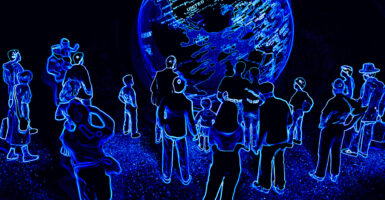If the metaverse sounds like something from a science fiction novel, that’s because it is.
Neal Stephenson’s 1992 novel “Snow Crash” tells the story of a young man who delivers pizzas in the real world, but is a warrior prince in the virtual metaverse. But 30 years later, the metaverse is moving from the pages of fiction to reality.
The novel’s metaverse “was supposed to be a virtual world that should terrify the reader,” Kara Frederick, director of The Heritage Foundation’s Center for Technology Policy, told The Daily Signal in an interview. But today, “it’s terrifying us in real life.”
So what exactly is the metaverse?
When fully implemented, the metaverse will be a virtual world in which human beings may interact with one another in a way that mimics reality. In theory, people could gather for meetings, attend concerts, and visit museums in the metaverse.
Last year, Facebook founder and CEO Mark Zuckerberg changed the name of his social media company to Meta and spoke about his belief that the company’s future lies in the metaverse.
“I think over the next five years or so, in this next chapter of our company, I think we will effectively transition from people seeing us as primarily being a social media company to being a metaverse company,” Zuckerberg told “The Vergecast” podcast last July.
A lot remains unknown because Meta and other companies are still developing the metaverse, but clearly that virtual world has a place in the future whether we like it or not.
The more we learn about the metaverse, the more questions arise. So The Daily Signal asked Annelise Butler, research associate at The Heritage Foundation’s Center for Technology Policy, to answer a few of the questions so many are asking about this new virtual world.
Q: What can the metaverse do and how do users interact with, or in, the metaverse?
A: The metaverse is the virtual space where participants, using virtual reality or augmented reality devices and using apps or games, interact in a virtual, 4-D manner. It provides ongoing physical audio and visually enhanced immersive experiences, meaning you can stay in the metaverse for as long as you like.
Activities that currently take place in specific physical environments will eventually have the ability to take place in a metaverse, such as:
- Buying digital land and constructing virtual homes.
- Participating in a virtual social experience.
- Shopping in virtual malls via immersive commerce.
- Using virtual classrooms to experience immersive learning.
- Buying digital art, collectibles, and assets (NFTs, or non-fungible tokens).
- Interacting with digital humans for onboarding employees, customer service, sales, and other business interactions.
Q: Some are calling the metaverse the “new internet.” What does that mean? Will the metaverse replace the internet?
A: The metaverse will not replace the internet. In fact, Mark Zuckerberg calls the metaverse “the embodied internet.” It uses the internet to provide its services.
For example, blockchain and Web2 applications like YouTube and Facebook haven’t replaced the internet; instead, they are products that use the internet.
The metaverse will serve its purpose as a virtual space to conduct VR [virtual reality] and AR [augmented reality] experiences, but it will not replace our existing websites and apps. Technically, the metaverse is built on top of blockchain technology, which is built “on top” of the internet.
The metaverse will simply enhance the internet user experience. Because the metaverse is built on top of the internet, it acts as an added perk more than an overall improvement or replacement to internet functionality.
Q: How might social institutions, like churches and workplaces, begin using the metaverse?
A: Churches could use the metaverse to have people (avatars) join virtual church services from wherever they are in the world. This would be similar to the start of the pandemic, when people watched livestreams of church services instead of attending in person.
But for example, in Catholicism, the celebration of Mass culminates in the consumption of the body and blood of Christ. This can’t be done watching a livestream or attending as an avatar with AR goggles on.
Sheryl Sandberg, COO of Meta Platforms Inc., laid out her vision in 2021: “Our hope is that one day people will host religious services in virtual reality spaces as well, or use augmented reality as an educational tool to teach their children the story of their faith.” [Sandberg last week announced that she plans to step down in the fall.]
Workplaces are the more likely of the two [work and church] to utilize the metaverse. We already live in a world of remote or hybrid jobs, so companies that allow such environments will likely transition to holding online meetings and other office activities in the metaverse [among] teleporting holograms [of participants].
Have an opinion about this article? To sound off, please email letters@DailySignal.com and we’ll consider publishing your edited remarks in our regular “We Hear You” feature. Remember to include the URL or headline of the article plus your name and town and/or state.


























